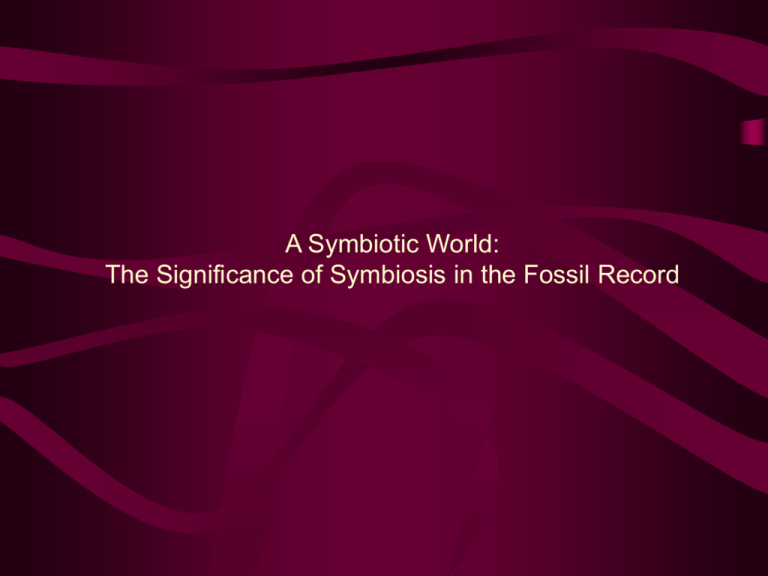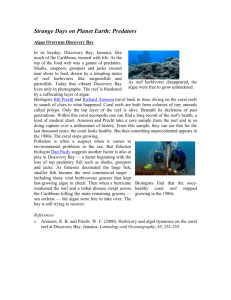Calyptogena magnifica
advertisement

A Symbiotic World:
The Significance of Symbiosis in the Fossil Record
Reefs: Rainforests of the Marine Realm
A reef, rising above the sea floor, is an entity of its own
making - a sedimentary system within itself. The numerous,
large calcium carbonate secreting organisms stand upon the
remains of their ancestors and are surrounded and often
buried by the skeletal remains of the many small organisms
that once lived on, beneath, and between them.
- Noel James
Reefs Through Time
Note: The dominant reef-builders and reef-dwellers have changed
through time as a result of extinction and evolution
Probably all powered by photosynthesis
Advantages of Algal Symbiosis
Some corals grow up to 25 cm per year !
Such intense production of calcium carbonate is only possible with the
help of certain algae (known as Zooxanthellae).
These algae live in the soft tissues of the coral (Fig. 6).
Due to their photosynthetic lifestyle they produce carbohydrates which
are, to a large part, used by the coral animal.
Significance of Phosphates
On the other hand, the algae gain protection and can use
phosphates and carbon dioxide produced by the coral.
Phosphates inhibit the growth of calcareous coral skeletons but
are a must for algal growth, although they are very rare in the
nutrient deserts of the tropical seas.
Only by this interdependent relation are reef corals able to grow
rapidly despite the overall lack of nutrients.
Zooxanthellae control saturation of calcium carbonate in coral
Zooxanthellae in tentacle of coral
CaCO3 + CO2 + H2O = HCO3- + Ca 2+
Decrease CO2 in coral tissues,
drive reaction to left, in favour of carbonate production
Reef Zonation
Form of reef builders dependent on physical agitation,
light availability and sedimentation rate
Massive reef limestone (right) of the Nansen Formation (PermoPennsylvanian) extending downward and basin ward into dark,
argillaceous limestones of the Hare Fjord Formation (left). Arrows
point out small reef mounds developed on the seaward slopes of the
reef front, western side of Blind Fjord, Ellesmere Island, N.W.T.
Precambrian (Archaean to Proterozoic)
Dominant Reef Builders: Cyanobacteria
Stromatolite mound of
Proterozoic age
Kuuik Formation,
Kilohigok Basin,
Northwest Territories
Cambrian
Dominant Reef Builders:
Archaeocyathans (sponges) and skeletal algae
Reef in Newfoundland
Cross section of
Archaeocyathan sponge
Ordovician-Silurian:
Mostly mudmounds (dominated by algae, bryozoa and microbes)
Stromatactis, sub-horizontal layers
of calcite spar illustrating irregular
digitate tops and smooth bottoms,
from Gros Morne, reefmound
facies, Silurian West Point reef
complex, Gaspé, Quebec.
Possibly due to
cyanobacterial decay
Devonian:
Dominated by stromatoporoids (sponges) and corals
Encrusting
stromatoporoid
The diversification stage of an Upper Devonian reef,
comprising domal stromatoporoids, and domal to branching
tabulate corals, Blue Fjord Formation, south side of Eids
Fjord, Ellesmere Island, N.W.T.
Carboniferous-Permian
Dominated by algae, bryozoa (many mudmounds)
Muleshoe bioherm, a 60 m high reef
mound of Late Mississippian age exposed
along the western escarpment of the
Scaremento Mountains, New Mexico.
A well-developed Permian reef:
El Capitan in Guadalupe Mountains, New Mexico/Texas
Triassic-Jurassic
Dominated by stromatoporoids, other sponges and few corals
sponges
corals
Cretaceous
Dominated by rudists and corals
Rudists: bizarre reef-building clams !
Cenozoic (both Paleocene and Neogene)
Dominated by corals
Some other photosymbiotic critters
The giant clam Tridacna. This is a species which
lets itself become partially overgrown by a coral.
The colors are largely due to the chlorophyll of the
photosymbiontic algae living in the soft tissue
('mantle') of the clam.
Giant foraminifera
Reef-dwelling brachiopods
(Permian)
Chemosymbiosis
Just as photosynthesis provides nutrition for hosts of endosymbiotic
algae, so too can chemosythesis for hosts of endosymbiotic
sulphide-oxidiving bacteria.
Chemosynthesis is the basis for deep sea communities that live
around hydrothermal vents at midocean ridges.
Vent Faunas
Many species of organisms are uniquely
adapted to conditions associated with
hydrothermal vents.
The Giant Tubeworm is one of the most
common vent dweller (ranging up to 2
metres in length).
The red “plume” of the tubeworm act as
a gill to exchange water, dissolved
gases, and waste.
But the actual “work” is done by bacteria
housed in the trunk of the animal.
Endosymbiotic bacteria oxidize sulphide in this way
(forming sugars).
4H2S + CO2 + O2 --> CH2O + 4S + 3H2O
Sugars that are not used by the
bacteria are transferred to the
tubeworms.
Incredibly, these worms have
no gut or anus !
The bacteria supply all the
nutritional needs of the
tubeworm.
In return for supplying the
tubeworms with food, the
tubeworms function as a
supplier of sulphide and carbon
dioxide.
Both parties are happy.
Some clams, also housing chemosymbiotic bacteria work in
a similar way to that of the tubeworms. The clam
Calyptogena magnifica grows to extremely large sizes,
sometimes exceeding 20 cm in length.
Crustaceans, such as crabs and shrimps have become specialized to
sweep bacteria into their mouths.
In turn, crustaceans, and fishes feed on dead animals and the various
inhabitants of the vent community (including tubeworms)
So vent communities are very ecologically complex.
An increasing number of fossil
hydrothermal vent communities have
been found in terrestrial massive
sulphide deposits from around the World
(currently at least 20).
The oldest of these communities
(Silurian) is approximately 430 million
years old. All of the fossil vent
assemblages contain worm tubes
(analogues to modern vent tubewormd).
, some of which have been identified as
polychaete and vestimentiferan tubes.
Some assemblages also contain a small
diversity of brachiopods and molluscs.
Expect to hear more about fossil vent
communities in future scientific literature
!
Fossil brachiopod in ancient
hydrothermal vent deposit.
While we often think that endosymbiosis is strange in a
biological sense, it is more widespread than one might
think !
END OF LECTURE







